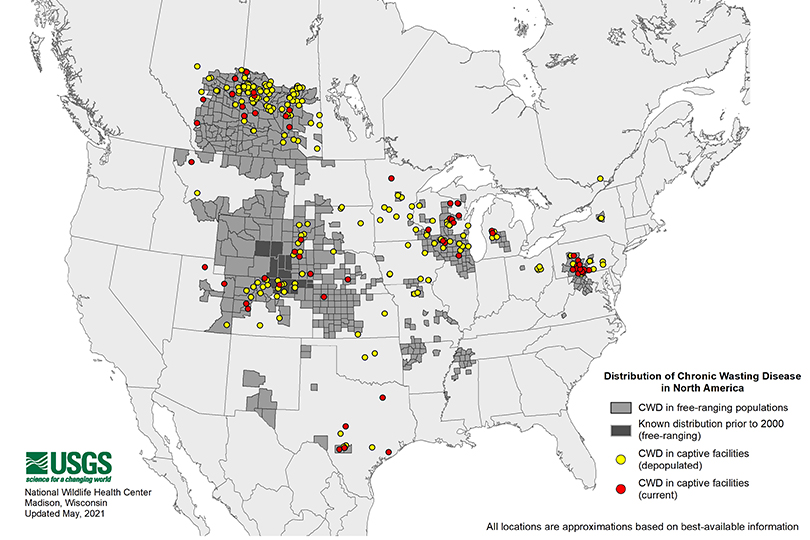By Jennifer Whitlock
Field Editor
Chronic Wasting Disease (CWD) was confirmed in two white-tailed deer from breeding facilities in Matagorda and Mason counties. Both facilities had received deer from an Uvalde County property confirmed positive for CWD in March.
Postmortem tissue samples were submitted by the deer breeders to assist Texas Parks and Wildlife Department (TPWD) and Texas Animal Health Commission (TAHC) with an epidemiological investigation. The National Veterinary Services Laboratory (NVSL) in Iowa confirmed CWD in those tissue samples.
“Each facility had one deer that tested positive. Those deer originated from the previous positive facility located in Uvalde County,” Dr. Susan Rollo, TAHC state epidemiologist, said in an interview with Texas Farm Bureau Radio Network.
All cervids from those properties were secured by TPWD and TAHC while the agencies conduct additional CWD investigations. In breeding facilities, TAHC recommends all animals be depopulated to prevent further transmission of the fatal neurological disease.
According to TAHC, prions are shed from infected animals in saliva, urine, blood, soft antler material, feces or from the decomposition of an infected animal. The prions then stay in that environment and can infect free-ranging or native deer herds in the area.
The disease was likely caught early enough that it will not spread to free-ranging populations in the area, but Rollo said deer can carry and transmit the disease without being outwardly symptomatic.
“Deer do not look symptomatic immediately when they get CWD, and it has a long incubation period. From exposure and infection to when animals start shedding and become symptomatic is a long time, anywhere from 18 months up to three-and-a-half years or so. It’s a hard disease to manage and find unless you’re testing all mortalities in a herd,” Rollo said. “We’ve found that you cannot tell most of the deer in positive herds had CWD by looking at them. In some cases, there were clinical signs, but they can shed the disease long before they start displaying clinical signs.”
When the agency identifies an animal from a breeding facility as CWD-positive, TAHC traces all animals sold from that premises within the previous five years.
The “trace animals,” are located and euthanized if still alive, and the premises where they were located is quarantined.
Postmortem samples are required on the trace animals to determine whether CWD was present. If the trace animal is no longer alive, TAHC may require breeders to conduct additional sampling in the herd to detect the presence of CWD.
“We are concerned because those two facilities in Matagorda and Mason county had positive animals that were traced deer [from the CWD-positive Uvalde County facility],” Rollo said. “That illustrates the urgency for us to remove all CWD-exposed deer, which would be the deer which have left a positive herd within the past five years.”
TPWD and TAHC consider the cervid-breeding and wildlife industries partners in controlling the risk and spread of CWD, Rollo said.
“We are working with breeding facilities, and we continue to discuss ways to improve rules and regulations that help mitigate risk,” she said. “We also continue to look for more ways to identify disease early, which will ultimately prevent spread.”
Cervids infected with CWD may not produce visible signs for years after becoming infected. As the disease progresses, animals begin to show changes in behavior and appearance, including progressive weight loss, stumbling or tremors with lack of coordination, excessive thirst, salivation or urination, loss of appetite, teeth grinding, abnormal head postures and drooping ears.
The disease is thought to spread between cervids through body fluids like feces, saliva, blood or urine through direct contact or indirectly through contaminated soil, food or water sources, according to the U.S. Centers for Disease Control and Prevention (CDC) (https://www.cdc.gov/prions/cwd/transmission.html).
To date, there is no evidence CWD poses a risk to humans or non-cervids, but CDC does recommend avoiding the consumption of meat from infected animals.
For more information on CWD in Texas, visit TAHC’s website and TPWD’s website.
An online national map tracking CWD is also available from the U.S. National Wildlife Health Center.

